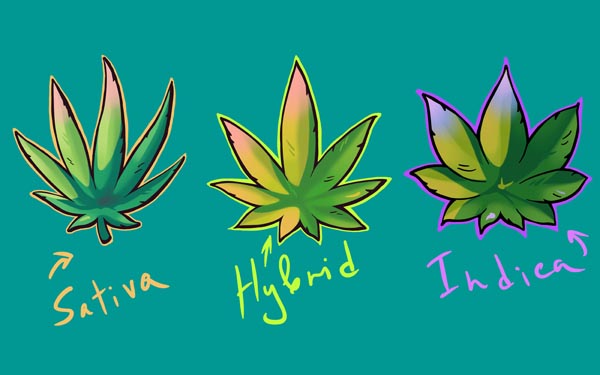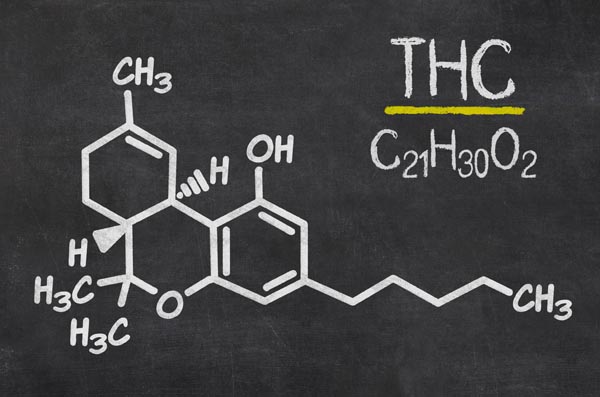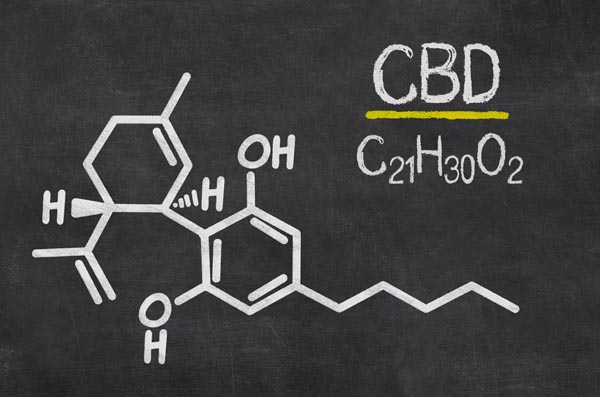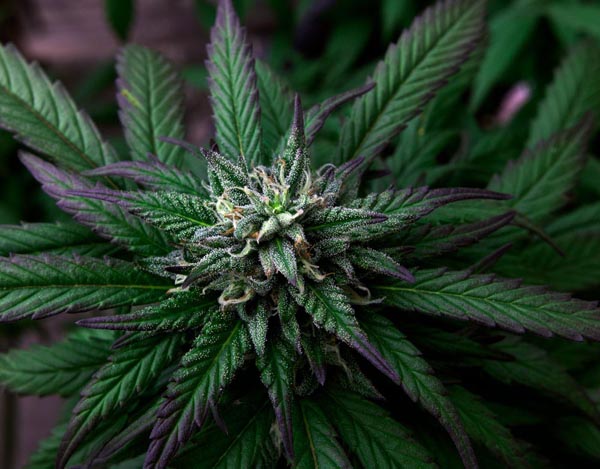The Kanteeva Strain Guide
The Kanteeva Strain Directory has been created to help simplify the complex world of medical cannabis so that you can find the strains that work best for you and your ailment(s). This strain guide has been created to help you understand how our Strain Directory works.
We have created a simple, yet effective way to categorize and define a strain using seven categories:
- Strain Variety
- THC Content
- CBD Content
- Positive Effects
- Potential Adverse Effects
- Commonly Used For
- Time of Day
These seven categories are used to help people more easily identify a strain and its characteristics, including its potential medical benefits.
The descriptions of each section below will explain each category in detail, so you can gain insight about why these categories are important to understand.
Strain Variety
 Typically, there are two main varieties of cannabis that the cannabis industry uses to identify and categorize a strain: Sativa and Indica. Knowing the difference between these two “mainstream varieties” is important because it is the key for learning about strains and understanding their individual effects and unique characteristics.
Typically, there are two main varieties of cannabis that the cannabis industry uses to identify and categorize a strain: Sativa and Indica. Knowing the difference between these two “mainstream varieties” is important because it is the key for learning about strains and understanding their individual effects and unique characteristics.
The two other varieties of cannabis, Ruderalis and Afghanica, are not often given credit or acknowledgement in the modern cannabis industry due to many complexities that were caused by the “underground” cannabis industry in the past.
To learn more about these cannabis varieties and cannabis in general, we invite you to read our Kanteeva article, "What is Cannabis?”
What is a Sativa?
Sativa varieties often provide uplifting and energizing cerebral effects. Sativa strains typically work well for daytime use when you need to be focused, alert and productive. The shape of the plant, and the leaves, are tall and thin, while the colour is usually a lighter shade of green. Sativas traditionally have a higher ratio of THC to CBD when compared to Indicas and have been reported by medical patients to help treat many mental ailments such as depression, ADHD and fatigue.
What is an Indica?
This species typically provides a physical “body high” and works well for evening and night time use, as the typical Indica effects promote rest and relaxation. Indica plants are shorter in stature and very bushy, with leaves that are short and broader than Sativas.
Traditionally, Indica strains usually have higher CBD to THC ratios when compared to their Sativa counterparts.
This is not always the case, since the majority of modern underground cannabis breeding has pushed for higher THC content in most strains because they were developed specifically for the recreational market which demanded potent THC levels.
These “underground” conditions have caused many modern Indica strains to have little or no CBD content and many of the “original” Indica strains are extinct or extremely rare. We here at Kanteeva predict that many classic strains will be reintroduced into the cannabis market over the next 20 years and hopefully will phase out many modern “phenotype” strains that are either identical to one another or only have slightly subtle differences.
Many of the genetically pure “landrace strains” that are nearly extinct, or are currently inaccessible to most cannabis patients, could have huge medical benefits due to their unique chemical profiles, as opposed to their recreational benefits.
Many experts agree that Indica strains are for the body while Sativa strains are for the mind.
To learn more about the differences between Indica and Sativa cannabis varieties, we invite you to read our "Indica vs Sativa" article.
What is a Hybrid?
Hybrid Strains are strains that are a genetic mix of the different varieties of cannabis. These Hybrid strains have been created through intentional breeding programs, by chance, or by the intervention of mother nature.
These Hybrids take on the characteristics of their parent strains and inherit genetic traits in the same way humans do.
These parental genetics, along with environmental conditions and human nurture, are combined together to create a “Hybrid Strain.” Some Hybrid strains are tried, tested and true, while others are rare and have inconsistent characteristics.
Depending on the genetics and environmental growth conditions of a cannabis plant, different ratios of cannabinoids and terpenes are produced, and infinite variations are possible through selective breeding and blending of different chemotypes (Lewis et al., 2017).
Since the term “Hybrid” is so general in nature, the cannabis industry has created three sub-categories that are typically used to further breakdown the “Hybrid” category:
- Sativa Dominant Hybrids
- Indica Dominant Hybrids
- 50/50 Hybrids
These three Hybrid categories help make identifying a specific strain and its potential effects more manageable for the average person.
What Cannabis Varieties do we use?
We here at Kanteeva, like much of the cannabis industry, use five categories to identify a cannabis strain:
- Indica (over 90% Indica)
- Sativa (over 90% Sativa)
- Hybrid - 50/50 (50% Indica and 50% Sativa)
- Hybrid - Indica Dominant (51% - 90% Indica)
- Hybrid - Sativa Dominant (51% - 90% Sativa)
Hybrids will take characteristics from both their Indica and Sativa lineages. Think about breeding a poodle with a bulldog …
As you can see, this method for identifying a modern cannabis strain can make everything from buying, growing and evaluating your medical cannabis more manageable.
To learn more about cannabis strains we invite you to read our article “What is a Strain?”
THC Content

Tetrahydrocannabinol, or THC, is the primary ingredient that is responsible for the mood altering high that is associated with consuming cannabis and is the main psychoactive compound produced by the cannabis plant. THC is one of almost 150 cannabinoid compounds, or phytocannabinoids, that are found in cannabis and is the most well known cannabinoid in the world.
The psychoactive “high” is not the only effect that THC produces. THC interacts with other cannabinoids, and cannabis compounds, working together to create medical effects that can help treat the symptoms of many common ailments.
These interactions are called “The Entourage Effect” and the medical and scientific communities are just starting to understand its medicinal importance!
Typically, the higher the THC content a strain possesses the more potent it will be in terms of the psychoactive “high” and the other medicinal effects that THC can provide. On the other hand, it is important to understand that the overconsumption of THC can cause people to feel uneasy and anxious and can induce paranoia or headaches, so like most medicine more is not necessarily better.
THC is a powerful chemical compound that must be used responsibly, with knowledge and understanding, or it can cause uncomfortable adverse effects.
THC is a complicated subject so we have gone into more detail in our Kanteeva article, “What is THC?.”
To breakdown the THC Content of a strain there are 5 subcategories that we use:
- Very Low (less than 5%)
- Low (5% - 10%)
- Medium (11% - 15%)
- High (16% - 20%)
- Very High (21% or more)
The difference between “Very High” and “Very Low” levels of THC content in a strain will make a massive difference in terms of the psychoactive effects it produces for the user. Patients need to be careful and understand this concept so they can function at optimal levels while using medical cannabis.
Although most modern cannabis strains have been bred to produce high levels of THC, there are also strains that have been designed to have a “Low” THC content in order to limit the experience of an intense psychoactive “high.” Other strains have been bred to have almost no THC content and will produce an experience with no psychoactive “high” at all. An example of this type of strain is Harle-Tsu, it has an average of 1% - 3% THC and its psychoactive effects are little to none.
CBD Content
 Cannabidiol, or CBD, is a cannabinoid compound that has been receiving enormous amounts of attention from the media in the last few years because of its medicinal properties and non-psychoactive effects. CBD is usually the cannabinoid that has the second highest concentration in most cannabis strains, behind THC.
Cannabidiol, or CBD, is a cannabinoid compound that has been receiving enormous amounts of attention from the media in the last few years because of its medicinal properties and non-psychoactive effects. CBD is usually the cannabinoid that has the second highest concentration in most cannabis strains, behind THC.
CBD is one of almost 150 cannabinoid compounds found in cannabis and is the second most well known cannabinoid in the world.
CBD is commonly used to help treat seizures, epilepsy, inflammation and anxiety. CBD is believed to counter the effects of THC, so the more CBD you have in a strain may limit the psychoactive effects of THC.
There is also a strong case from anecdotal evidence provided by medical cannabis patients that suggests that CBD is best utilized when it is taken orally, as opposed to inhaled by smoking or vaporizing.
CBD is also used topically in creams and salves. Many patients report that these topical CBD treatments help with inflammation of the joints and arthritic pain.
We have 5 subcategories for CBD Content:
- Very Low (less than 0.25%)
- Low (0.25% - 0.99%)
- Medium (1.0% - 3.99%)
- High (4% - 8%)
- Very High (more than 8%)
Recently, cannabis breeders have been able to create strains that have very high CBD content and almost zero amounts of THC content. These strains are still rare but are gaining popularity in the medical community, especially with children and young adults.
CBD is a complicated subject so we have gone into more detail in our Kanteeva article, “What is CBD?”
Potential Positive Effects
All cannabis strains have potential positive effects. These effects will differ from patient to patient and some of these effects will be wanted or unwanted by patients depending on circumstances and individual needs.
Potential Positive Effects are broken down into 7 subcategories:
- Euphoric
- Sedated
- Energetic
- Relaxed
- Hungry
- Focused
- Creative
It is important to remember that just because a strain works for you does not mean it will work the same way for someone else.
Finding the right cannabis strain and desired balance of effects is very important for each person's medical cannabis program.
Potential Adverse Effects
All cannabis strains have varying potential adverse effects that will vary from patient to patient. For example, a certain strain may produce feelings of paranoia for one person, while the same strain can produce focus or mental clarity for another.
Potential Adverse Effects are broken down into 6 subcategories:
- Anxious
- Hungry
- Paranoid
- Sedated
- Couch Locked
- Confused
Remember, you need to experiment with different cannabis strains to find out which ones work best for you and your aliments(s).
Commonly Used For
Certain cannabis strains are commonly used for specific symptoms. Knowing what symptoms you want relief from is important when choosing strains for your medical cannabis therapy.
There are 11 Symptom subcategories:
- Pain
- Anxiety
- Muscle Spasms
- Stress
- Depression
- Insomnia
- Lack of Appetite
- Fatigue
- Seizures
- Nerve Pain
- Nausea
- Inflammation
Time of Day
Different cannabis strains tend to be best consumed during specific times of the day. We have four categories for the Time of Day:
- Morning
- Afternoon
- Evening
- Bedtime
Final Thoughts
 As you can see, there are many different factors that we here at Kanteeva use to break down a strain and its tangible characteristics. These factors can be found in our Strain Directory, so you can simply find information about a specific strain.
As you can see, there are many different factors that we here at Kanteeva use to break down a strain and its tangible characteristics. These factors can be found in our Strain Directory, so you can simply find information about a specific strain.
Remember specific strains typically work better for specific symptoms.
For example, if you were wanting to improve your sleep due to insomnia than a heavy Indica strain, like Granddaddy Purps, would most likely help. We say "most likely" because everybody will react differently to each strain, yet for the most part you will be affected at a base level in the same way as the majority of people.
We invite you to take advantage of our Strain Directory and the Kanteeva community so we can help guide you in the right direction. The primary research is up to you.
Everyone is unique and reacts differently to specific strains, their unique cannabinoid profiles, and to specific applications as a result of the complexities of our own unique endocannabinoid systems. This being the case, what might work for you may not work for someone else, so do not be discouraged if you are not successful right away.
Trial and error is as important as education in our opinion.
We Want to Hear From You
 We have spent countless hours perfecting how to effectively break down a cannabis strain so everyone who is willing and able can start practicing Strain Management in order to combat their ailments and improve their quality of life.
We have spent countless hours perfecting how to effectively break down a cannabis strain so everyone who is willing and able can start practicing Strain Management in order to combat their ailments and improve their quality of life.
We welcome you to visit the Strain Directory. Learn which strains will work best for you and please share your results with us and the Kanteeva Community.
Have you had success with specific strains? Share your experience with us by commenting below. We also invite you to join the Kanteeva community to learn more and to stay connected.
We wish you well with your search!
Learn. Share. Connect.
